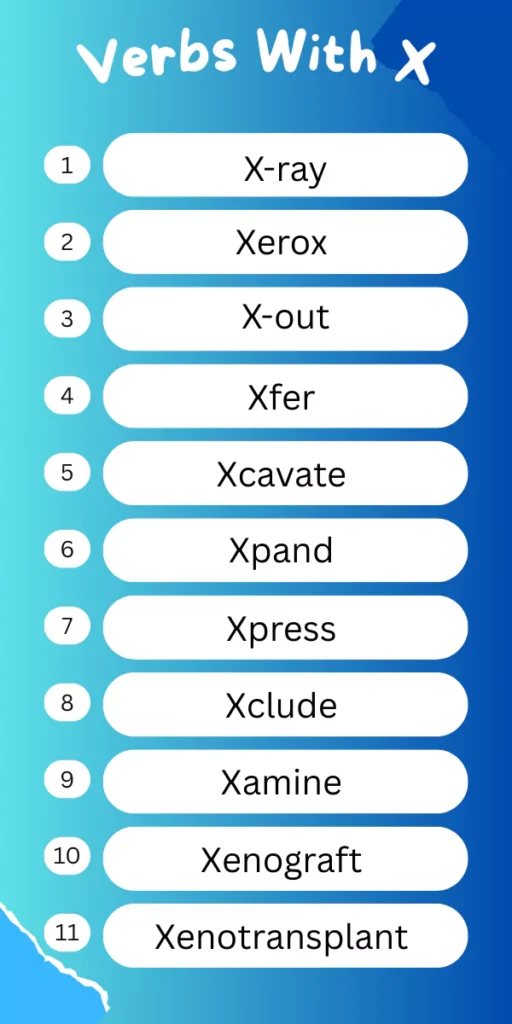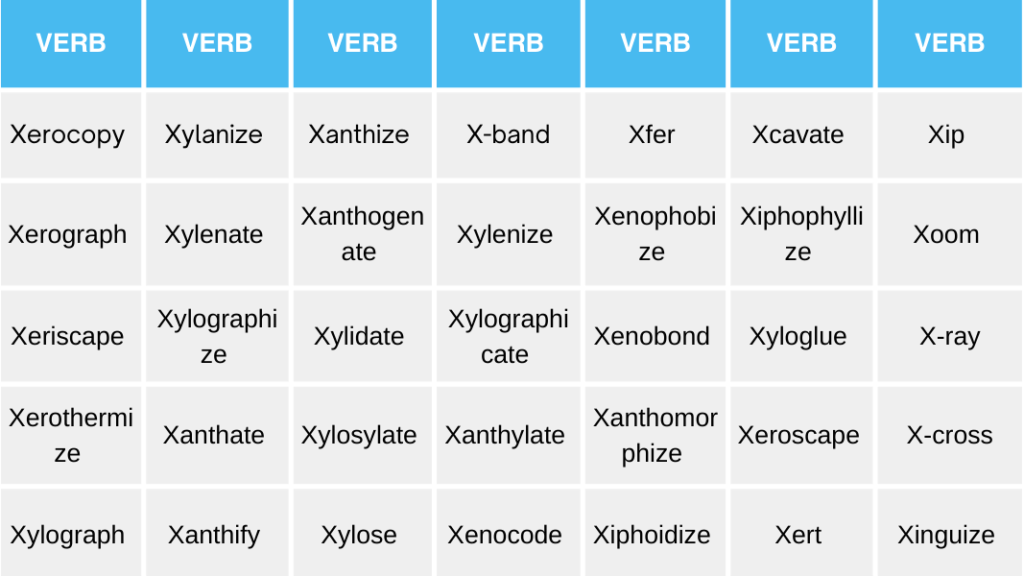Verbs That Start With X – List of Positive, Action, and Common X Verbs

The letter X may be tucked away near the end of the alphabet, but it certainly knows how to stand out. While verbs that start with X are rare in English, the few that exist bring an exciting spark to language learning. From everyday actions like “xerox” or “x-ray” to more advanced terms such as “xenograft”, these words showcase the versatility and depth of the English vocabulary. Introducing children (and even adults!) to X-verbs not only builds curiosity but also adds a playful and memorable twist to their learning journey.
List of Verbs That Start With X
- X-ray – To scan or examine with X-rays.
Example: The dentist x-rayed her teeth. - Xerox – To photocopy documents.
Example: He xeroxed the report for his colleagues. - X-out – To cross something out.
Example: She x-outed the incorrect answer. - X-mark – To place an X as a sign.
Example: They x-marked the treasure spot. - X-sign – To mark something with an X signature.
Example: The contract was x-signed by both parties. - X-flag – To signal or highlight with an X.
Example: He x-flagged the error for correction. - X-check – To double-check using an X symbol.
Example: She x-checked the homework answers. - X-code – To encode with an X mark.
Example: The technician x-coded the faulty entries. - X-log – To record with an X symbol.
Example: The scientist x-logged the test results. - X-frame – To outline with an X.
Example: They x-framed the construction site plan.

- Xenograft – To transplant tissue between species.
Example: Doctors xenografted pig skin onto burns. - Xenotransplant – To transplant organs across species.
Example: They xenotransplanted a pig heart into a patient. - Xiphoidize – To form a sword-like shape.
Example: The crystals xiphoidized under pressure. - Xerophyte – To adapt to dry environments.
Example: Plants xerophyte to survive in deserts. - Xylophone (as a verb) – To play a xylophone.
Example: The child xylophoned a cheerful tune. - Xenocode – To program across systems.
Example: The developer xenocoded the app for testing. - Xerograph – To print using xerography.
Example: The office xerographed the pages quickly. - Xenolith – To embed foreign rock.
Example: The magma xenolithed fragments during cooling. - Xenocryst – To form a foreign crystal in magma.
Example: The lava xenocrysted quartz pieces. - Xylograph – To engrave on wood.
Example: The artist xylographed a floral design. - Xylographize – To create prints from woodcuts.
Example: She xylographized her artwork. - Xylotomize – To cut thin sections of wood for study.
Example: The scientist xylotomized samples under a microscope. - Xeriscape – To landscape with drought-tolerant plants.
Example: They xeriscaped the garden for water conservation. - Xenophobize – To make someone fearful of foreigners.
Example: Propaganda xenophobized the crowd. - Xenophilize – To make friendly toward strangers.
Example: Education xenophilized the community. - X-draw – To cross out with a line.
Example: He x-drew the mistake in red. - X-point – To highlight with an X.
Example: She x-pointed the key section in the text. - X-mark-off – To cancel or remove.
Example: They x-marked-off completed items. - X-note – To annotate with an X.
Example: The reviewer x-noted the errors. - X-scale – To measure against a scale.
Example: The engineer x-scaled the diagram. - X-time – To record with an X timestamp.
Example: The guard x-timed every entry. - X-trace – To follow a path using X marks.
Example: He x-traced the missing package. - X-symbolize – To represent with an X.
Example: The map x-symbolized the danger zone. - X-locate – To mark a location with X.
Example: They x-located the campsite on the map. - X-enroll – To sign up by marking with X.
Example: He x-enrolled in the program. - X-approve – To mark something as accepted.
Example: The manager x-approved the budget proposal. - X-cancel – To call off by marking with X.
Example: The editor x-canceled the wrong section. - X-pull – To withdraw with an X.
Example: She x-pulled her name from the list. - X-call – To cancel an event.
Example: The coach x-called the practice due to rain. - X-correct – To fix by marking.
Example: He x-corrected the quiz answers.

Fun Facts About Words Beginning With X
- X is Rare but Powerful – Only about 0.02% of English words start with the letter X, making it one of the rarest starting letters in the alphabet. Yet, many of them carry strong, impactful meanings like x-ray or xenon.
- Greek Roots Everywhere – Most words beginning with X come from Greek origins, where “x” often represents the Greek letter “chi” (χ). For example, xylophone comes from the Greek xylon (wood) + phone (sound).
- X as a Symbol – The letter X itself has been used for centuries as a symbol for the unknown, hidden, or mysterious, which is why words starting with X often sound exotic or scientific. Think of X-ray or X-factor.
- Kids Love X-Words – Even though X-words are rare, kids often learn them early because they’re fun, unusual, and visually striking. Words like x-ray and xylophone are staples in preschool alphabet books.
- The Versatility of X – In English, X can stand for both a sound and a symbol. It can mean “to cross out” (x-out), mark approval (x-mark), or even serve as shorthand for a kiss in “XOXO.” Few letters pull double duty the way X does!
Read: Verbs That Start With U
Read: Verbs That Start With V
Read: Verbs That Start With W
FAQs
Conclusion
Although verbs starting with X are rare in English, they bring a sense of uniqueness and power to the language. From simple and common words like xerox and x-ray to more advanced or scientific verbs such as xenograft and xenotransplant, each carries its own charm and impact. For learners, exploring X-verbs can be an exciting way to expand vocabulary, spark curiosity, and even add creativity to writing or speech. Whether you’re teaching children, improving your own word bank, or just love the quirks of language, these verbs prove that even the least common letters in the alphabet have something valuable to offer.
